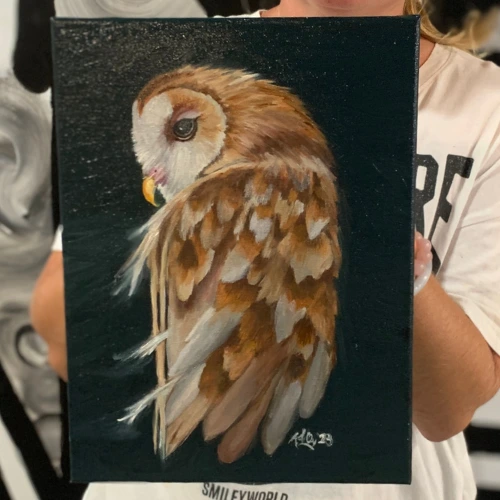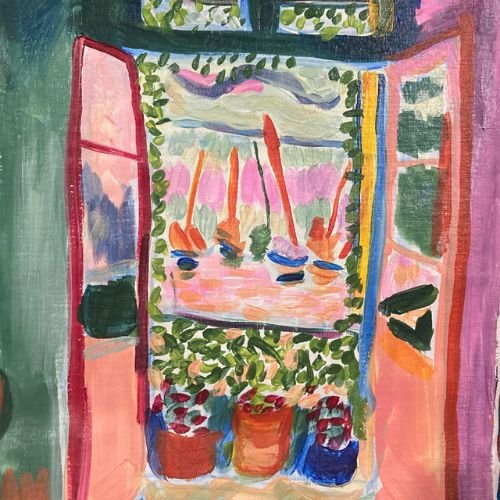Choosing Your Artistic Adventure
When you’re ready to dive into painting, one of the first big questions you’ll face is this: Acrylic vs Oil Painting—Which one is right for you? At The Artist Outpost in Ocean Beach, San Diego, we meet so many curious creatives just like you, wondering where to begin or how to expand their skills. Some love the quick-drying vibrancy of acrylics. Others are drawn to the rich, buttery textures of oils.
This blog is your go-to guide. We’re walking through the pros, cons, techniques, and real-world differences between acrylic vs oil painting, all from a friendly, supportive, and experience-based perspective. Whether you’re a complete beginner or someone looking to explore a new medium, you’ll find practical insights to help you paint with confidence.
And if you’re looking to try both mediums firsthand, check out our welcoming Painting Classes in San Diego—where your creativity gets the space to shine.

What is the Real Difference Between Acrylic vs Oil Painting?
The primary difference between acrylic vs oil painting lies in their composition, drying time, and handling. Acrylic paints are water-based and fast-drying, while oil paints are made with oil (typically linseed) and dry slowly over hours—or even days.
Because acrylics dry quickly, they’re great for layering and fast progress. Oils, on the other hand, offer luscious blending and a longer working time, ideal for capturing depth and subtle transitions.
Choosing between acrylic vs oil painting really comes down to your goals: Do you prefer quick wins or slow-building masterpieces?
Pros and Cons of Acrylic Painting
Let’s take a closer look at what makes acrylics a favorite for many artists, especially beginners.
Pros:
- Fast drying = instant gratification
- Easy cleanup with just water
- Less odor, making it ideal for indoor use
- Works on almost any surface (paper, canvas, wood, even glass!)
- Affordable and widely available
Cons:
- Dries too fast for some blending techniques
- Colors may dry darker
- Lacks the glossy finish of oil paint unless sealed
In short, acrylic vs oil painting often comes down to time. If you’re in a creative flow and love quick results, acrylic might be your medium.
Want to explore acrylic techniques further? Our article on 7 Must-Know Secrets to Master Painting for Beginners offers fantastic starting tips.
Pros and Cons of Oil Painting
Oil painting is timeless—and for good reason. The depth, richness, and history behind oil masterpieces are unmatched. But there are some things you should know before jumping in.
Pros:
- Long drying time allows extensive blending and layering
- Rich, vibrant colors with beautiful gloss
- Depth and realism are easier to achieve
- Paint remains workable for days
Cons:
- Long drying time can slow down progress
- Requires turpentine or mineral spirits for cleaning
- Higher chance of smudging if not handled carefully
- Needs proper ventilation
In the debate of acrylic vs oil painting, oils are the choice for those who want to savor the process and explore subtle detail work.
Techniques Unique to Acrylic vs Oil Painting
Techniques vary widely between the two mediums, and understanding what’s possible can help you decide what aligns best with your style.
Acrylic Techniques:
- Dry brushing for texture
- Layering and glazing with fast drying
- Pour painting and fluid effects
- Mixed media compatibility
Oil Techniques:
- Impasto (thick paint) for dramatic texture
- Wet-on-wet blending for seamless color transitions
- Glazing with transparent layers for luminosity
- Chiaroscuro and realism effects
At The Artist Outpost, we often recommend experimenting with both to discover your own preferences. Our students love blending mediums, and we welcome that kind of exploration in our painting classes.
Which Medium is Best for Beginners?
This is one of the most common questions we get: When starting out, is it better to try acrylic vs. oil painting?
Acrylics are usually the top recommendation for beginners.
Why? They’re affordable, dry quickly, and don’t require special tools or ventilation. Mistakes are easier to fix, and supplies are low-maintenance.
But don’t count oils out! If you have the time and patience, oil painting offers a rewarding, immersive experience. Many of our intermediate students fall in love with oils after starting with acrylics.
How to Choose Between Acrylic vs Oil Painting
Here are some quick questions to ask yourself:
- Do I need my art to dry quickly? → Go with acrylic.
- Do I want to blend soft transitions and work slowly? → Try oil.
- Do I prefer water cleanup? → Acrylic.
- Am I drawn to classic styles and realism? → Oil.
- Do I love experimenting and layering quickly? → Acrylic.
Still not sure? You’re not alone—and that’s where our welcoming studio environment helps. We believe the best way to find your favorite is to try both in a supportive space.
We’ve even designed intro-level classes for both acrylic and oil painting, so you can explore your own path with guidance and confidence.
Common Questions About Acrylic vs Oil Painting
Can I mix acrylic and oil paint?
Not directly. Acrylics are water-based and oils are, well, oil-based—like water and oil, they don’t mix. However, you can paint acrylic under oil, but never oil over acrylic.
Which lasts longer—acrylic or oil?
Oil paintings, when properly cared for, have stood the test of centuries. Acrylics are newer (introduced in the 1950s), but high-quality acrylics are made to last just as long.
Are oil paints toxic?
Many oil paints use heavy metals and require solvents for cleaning, which can be harmful in poorly ventilated spaces. However, modern water-mixable oils are a safer alternative!
Is acrylic painting cheaper than oil painting?
Generally, yes. Acrylic supplies are less expensive, and you won’t need solvents or special brushes.
What Students at The Artist Outpost Say
We love hearing from our Ocean Beach art community!
“I was nervous to try oils, but the way The Artist Outpost broke everything down made it feel totally doable.” — Jamie, OB local
“Acrylics helped me express myself quickly, especially as a busy parent. I can paint during naptime and not worry about wet canvases for days.” — Laura, San Diego
Our classes are shaped around these stories. Your journey matters to us, and we’re always adjusting to fit what you want to learn next.
Where to Explore More
Still curious about different painting mediums? We have a treasure trove of resources just for you:
- Painting Classes in Ocean Beach: Come join us for hands-on experience.
- 7 Must-Know Secrets to Master Painting for Beginners: Perfect for first-timers!
- 11 Watercolor Techniques Every Artist Should Know: Because trying new things keeps creativity alive.
Your Artistic Medium Awaits
Whether you’re leaning toward the bold efficiency of acrylics or the luxurious patience of oils, the beauty is that you don’t have to choose just one. At The Artist Outpost, we encourage you to explore both. Each has its magic—and discovering what speaks to you is part of the joy.
Acrylic vs Oil Painting isn’t a battle. It’s a conversation. And the best way to join it is to start creating.
Come see what you’re capable of. We’re here, brushes ready, whenever you are.






